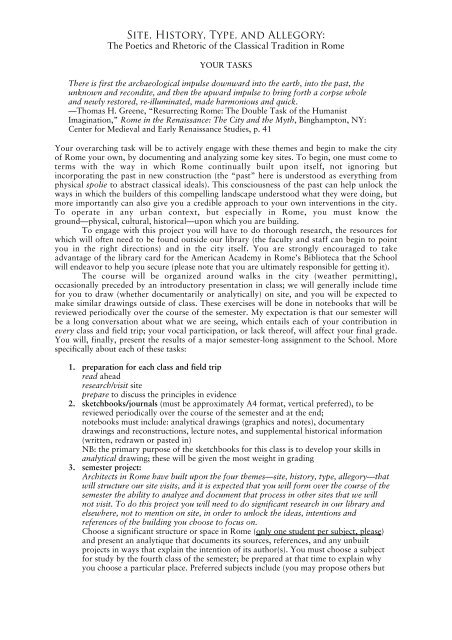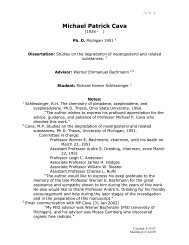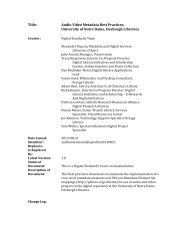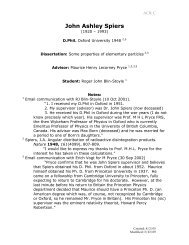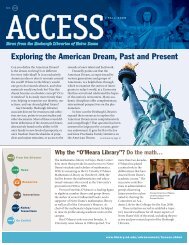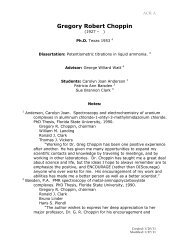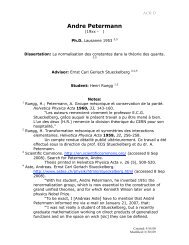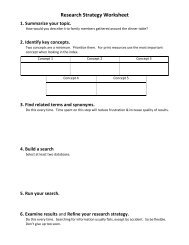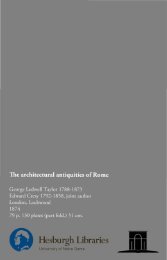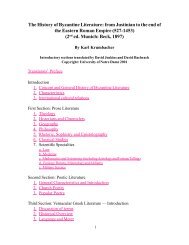ARCH 84312
ARCH 84312
ARCH 84312
Create successful ePaper yourself
Turn your PDF publications into a flip-book with our unique Google optimized e-Paper software.
Site, History, Type, and Allegory:<br />
The Poetics and Rhetoric of the Classical Tradition in Rome<br />
YOUR TASKS<br />
There is first the archaeological impulse downward into the earth, into the past, the<br />
unknown and recondite, and then the upward impulse to bring forth a corpse whole<br />
and newly restored, re-illuminated, made harmonious and quick.<br />
—Thomas H. Greene, “Resurrecting Rome: The Double Task of the Humanist<br />
Imagination,” Rome in the Renaissance: The City and the Myth, Binghampton, NY:<br />
Center for Medieval and Early Renaissance Studies, p. 41<br />
Your overarching task will be to actively engage with these themes and begin to make the city<br />
of Rome your own, by documenting and analyzing some key sites. To begin, one must come to<br />
terms with the way in which Rome continually built upon itself, not ignoring but<br />
incorporating the past in new construction (the “past” here is understood as everything from<br />
physical spolie to abstract classical ideals). This consciousness of the past can help unlock the<br />
ways in which the builders of this compelling landscape understood what they were doing, but<br />
more importantly can also give you a credible approach to your own interventions in the city.<br />
To operate in any urban context, but especially in Rome, you must know the<br />
ground—physical, cultural, historical—upon which you are building.<br />
To engage with this project you will have to do thorough research, the resources for<br />
which will often need to be found outside our library (the faculty and staff can begin to point<br />
you in the right directions) and in the city itself. You are strongly encouraged to take<br />
advantage of the library card for the American Academy in Rome’s Biblioteca that the School<br />
will endeavor to help you secure (please note that you are ultimately responsible for getting it).<br />
The course will be organized around walks in the city (weather permitting),<br />
occasionally preceded by an introductory presentation in class; we will generally include time<br />
for you to draw (whether documentarily or analytically) on site, and you will be expected to<br />
make similar drawings outside of class. These exercises will be done in notebooks that will be<br />
reviewed periodically over the course of the semester. My expectation is that our semester will<br />
be a long conversation about what we are seeing, which entails each of your contribution in<br />
every class and field trip; your vocal participation, or lack thereof, will affect your final grade.<br />
You will, finally, present the results of a major semester-long assignment to the School. More<br />
specifically about each of these tasks:<br />
1. preparation for each class and field trip<br />
read ahead<br />
research/visit site<br />
prepare to discuss the principles in evidence<br />
2. sketchbooks/journals (must be approximately A4 format, vertical preferred), to be<br />
reviewed periodically over the course of the semester and at the end;<br />
notebooks must include: analytical drawings (graphics and notes), documentary<br />
drawings and reconstructions, lecture notes, and supplemental historical information<br />
(written, redrawn or pasted in)<br />
NB: the primary purpose of the sketchbooks for this class is to develop your skills in<br />
analytical drawing; these will be given the most weight in grading<br />
3. semester project:<br />
Architects in Rome have built upon the four themes—site, history, type, allegory—that<br />
will structure our site visits, and it is expected that you will form over the course of the<br />
semester the ability to analyze and document that process in other sites that we will<br />
not visit. To do this project you will need to do significant research in our library and<br />
elsewhere, not to mention on site, in order to unlock the ideas, intentions and<br />
references of the building you choose to focus on.<br />
Choose a significant structure or space in Rome ( only one student per subject, please)<br />
and present an analytique that documents its sources, references, and any unbuilt<br />
projects in ways that explain the intention of its author(s). You must choose a subject<br />
for study by the fourth class of the semester; be prepared at that time to explain why<br />
you choose a particular place. Preferred subjects include (you may propose others but


